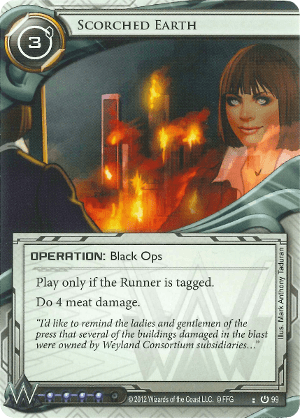Note: With this series I’m specifically interested in the way Netrunner expresses fiction through the interactions of its rules. These articles are not intended as analysis of cards in terms of their utility in competitive play.
Now we have an understanding of the rules we can explore another elements important to the expression of fiction in Netrunner, the way personality and context is supported by factions, identities, and influence.
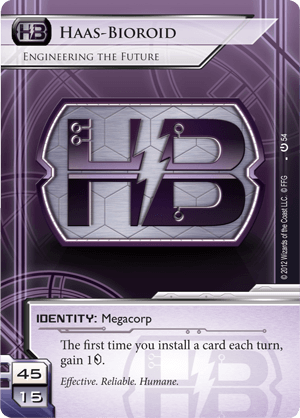
For both runners and corporations, the cards available in Netrunner are divided into two types: faction cards, and neutral cards. Every faction has a number of identities each with a unique ability. These identities represent the individuals or corporate divisions that you will play as. Decks are usually constructed around the ability of a specific identity, with this choice also serving to determine your faction.
There are three runner factions and two corporation factions; there are also three additional mini-factions on the runner side that come with their own specific identities and cards. Faction cards can be used freely by any identity within their faction, and come with an influence value (between 1 and 5 points) that indicates how costly they are to include in a deck of a different faction. Influence costs are only taken into account when constructing a deck, once a game has begun all cards in a deck behave as normal. It is from these faction specific cards that the strengths and weakness of the various factions emerge, where their personalities are defined.
Neutral cards can be used by anybody and provide generic abilities, such as reliable economy and card draw. Neutral cards exist to compensate for each faction’s weaknesses by offering straightforward alternatives to including, the usually more powerful, out of faction cards.
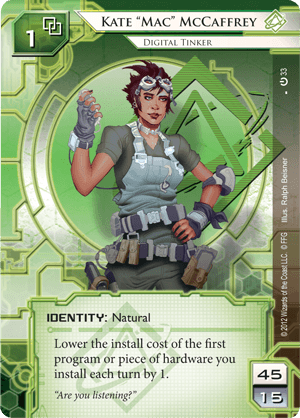
Along with their unique ability, each identity is defined by their minimum deck size and influence limit; the standard being a 45 card minimum deck size and a 15 point influence limit. Corporation decks needs to include agendas worth at least 20 points (rising by an extra 2 points for each additionally 5 cards). In general runner decks will stay at 45 cards, corporations will extend this to 49 allowing them to keep to the 20 agenda point limit while having 4 extra cards with which to decrease their agenda density. Some identities have different minimum deck sizes, 40 cards grants a more efficiency deck as each card has a slightly higher change of being drawn; while a 50 card minimum leads to the reverse. Larger minimum deck sizes are reserved for identities with particularly powerful abilities.
By expending their influence with other factions, runners and corporations can gain access to abilities that compensate for their weaknesses. NBN might be able to tag runners with ease, but they need to rely on Weyland to do something once they’ve found them. Criminals are out to make money, and sometimes that means exploiting their influence with Shapers to gain access to the powerful ICE breakers needed to breach a corporation’s HQ.
Though deck size and influence limits impact deck building, the ability is the primary factor when deciding on an identity.
The original identity for the Haas-Bioroid corporation, “Engineering The Future”, has an ability that means the first time you install a card (be that an asset, agenda, upgrade, or ICE) each turn you gain a credit. This is a powerful ability as you gain a credit for taking actions you want to be taking anyway.
On the runner side the original Shaper identity, Kate “Mac” McCaffrey, lowers the install cost of the first program or piece of hardware installed each turn by a credit. Again, a strong consistent ability, you gain a discount for doing something you want to be doing a lot.
Runners:
 Anarchists and revolutionaries, Anarchs are the all or nothing faction. They have some of the most powerful abilities in the game, but these come with significant drawbacks Though originally card draw was a challenge they now have some of the most consistent and reliable draw options in the game; the world changed and anarchy is starting to look like the best defense against corporate fascism.
Anarchists and revolutionaries, Anarchs are the all or nothing faction. They have some of the most powerful abilities in the game, but these come with significant drawbacks Though originally card draw was a challenge they now have some of the most consistent and reliable draw options in the game; the world changed and anarchy is starting to look like the best defense against corporate fascism.
Anarchs can burn through cards quickly, fortunately they also have ways of retrieving them once trashed. Cards represent both the things a runner can make use of (other people, their rig, their programs), and their own health; Anarchs will gladly burn through anything if it means getting what they want. Notably, they are also the only faction that has the ability to return a specific card of any type from their heap to their grip. With an Anarch nothing is wasted, even old friends.
Powerful, cheap, but with inherent limitations Anarch ICE breakers usually require support cards to work effectively. When facing ICE their strength is in dealing with barriers, they are the faction who tear down walls.
Faust is possibly the most pure distillation of the Anarch mindset. An AI ICE breaker than can interact with any form of ICE, it costs 3 credits to install and comes with a base strength of 2. By trashing a card from your grip you can increase the strength of Faust by 2, and trashing another card will break a single sub-routine. With Faust, and enough cards, Anarchs can get through almost any ICE they want to at the cost of trashing cards, and putting themselves within range of being flatlined. Software, hardware, friends? Doesn’t matter, Anarch will use you to get what they want. Fortunately, Anarchs have multiple in-factions ways of lowering the strength of ICE they are encountering, decreasing the number of cards that need to be trashed.
A deal with the devil, powerful abilities that might get you killed, that’s the Anarch approach.
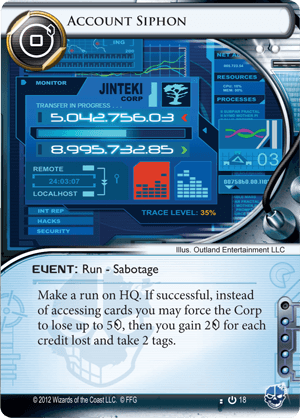 The runner faction with the strongest connections to the physical world, Criminals are all about action and exploitation. They have some of the most impactful events in the game, supported by numerous ways to make money. Though their software can be expensive to both install and use, they have several ways of manipulating ICE that don’t require the actual breaking of sub-routines. Through expose effects Criminals can reveal what an unrezzed card is without having to interact with it, letting them either avoid it or wait until they have the means of dealing with it. They can also bypass ICE entirely, or derez it, forcing the corporation to spent credits if they want to rez it again.
The runner faction with the strongest connections to the physical world, Criminals are all about action and exploitation. They have some of the most impactful events in the game, supported by numerous ways to make money. Though their software can be expensive to both install and use, they have several ways of manipulating ICE that don’t require the actual breaking of sub-routines. Through expose effects Criminals can reveal what an unrezzed card is without having to interact with it, letting them either avoid it or wait until they have the means of dealing with it. They can also bypass ICE entirely, or derez it, forcing the corporation to spent credits if they want to rez it again.
Criminals are tool users, not engineers, their ICE breakers are expensive, and they lack the means of returning them to play if they are trashed. Criminals lack Shaper’s consistent card draw, in return for better filtering options. If they want something they know exactly how to get it. Combined with their ability to reveal hidden information through expose effects, good Criminal players need never worry about facing a problem they can’t already deal with.
Where Shapers deal best with code gates, and Anarchs with barriers, Criminals have an affinity for sentries, the most directly punishing type of ICE. Sentries are usually represented as entities able to observe and identify runners. A consistent theme among killers (anti-sentry ICE breakers), is their ability to disguise a runner’s identity or otherwise trick the sentry, (Mimic, Alias, and Femme Fatale being three popular killers). Unsurprisingly Criminals have the most experience at identity theft and deception, their killers are some of the best in the game.
The nature of their work means Criminals accept getting located as an inherent risk, so they have several ways of either avoiding, or removing tags. These usually come courtesy of their various contacts throughout the criminal underworld, including corrupt politicians, and corporate employees.
A classic Criminal card is Account Siphon. For 0 credits you initiate a run against the corporation’s HQ, if successful instead of accessing cards you force them to lose up to 5 credits, then you gain 2 credits for each credit lost and take a total of 2 tags. The economic swing enabled by this card is dramatic and can be the difference between winning and losing, especially if you are able to perform multiple in a game. Taking 2 tags is a risk, though as each tag can be removed for a click and 2 credits you will have more than enough after a successful Account Siphon to deal with them. Usually though, manual tag removal is not necessary given how many ways Criminals have to remove tags at a reduced cost. An event that targets HQ, Account Siphon also synergies with other in-faction abilities that reward making runs on the corporation’s HQ.
Criminals are in it for the money, and they’re not above exploitation, manipulation and straight out brute force to get it.
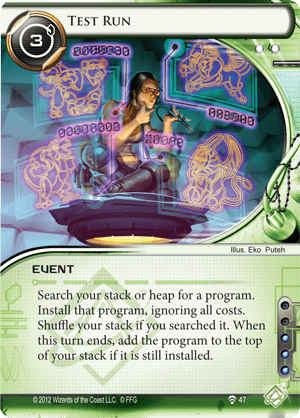 Shapers are the artists, engineers, and academics of the Andorid world. Theirs is the faction of powerful software and hardware, and the means of mitigating the cost (in both clicks and credits) of getting them into play. Representing both their mastery of technology, and the diverse communities they inhabit, Shapers have a lot of options to draw cards, but limited means of filtering that draw to ensure they get a specific card. Shapers make friends easily, though those friends can’t always provide exactly what they need.
Shapers are the artists, engineers, and academics of the Andorid world. Theirs is the faction of powerful software and hardware, and the means of mitigating the cost (in both clicks and credits) of getting them into play. Representing both their mastery of technology, and the diverse communities they inhabit, Shapers have a lot of options to draw cards, but limited means of filtering that draw to ensure they get a specific card. Shapers make friends easily, though those friends can’t always provide exactly what they need.
Hackers in the classic sense, Shapers understand the systems they are manipulating on a fundamental level, they can change ICE from one type to another, or find the exact tool for the job at a moment’s notice. As befits their position as masters of software the Shaper ICE breaker suite is most efficient at dealing with code gates; the most variable of the ICE types.
Not as obviously engaged in illegal activity as the other runner factions, Shapers are able to maintain strong relationships with academic institutes; a lot of their resources coming from universities and religious organisations.
Test Run is an example of a typical Shaper card. For 3 credits you can search your stack or the heap for a program and install it for the rest of the turn. Once this turn is over that card is returned to the top of your stack, where it can be drawn again during your next turn. With Test Run not only can you search for a specific card, but you can install it at a potentially reduced cost. Being returned to your stack after the turn mitigates some of its power, but now you know exactly where that card is, information that alone can be worth 3 credits. When targeting programs that have usage limits Test Run allows you to use those card more times than normal. Some programs need to be targeted at a specific server, and with Test Run you can try out a card against one server, before targeting it at another when you install it later.
Shapers are problem solvers, when they need a particular tool they find it, or just change the problem until it fits one of the tools they already have.
Corporations:
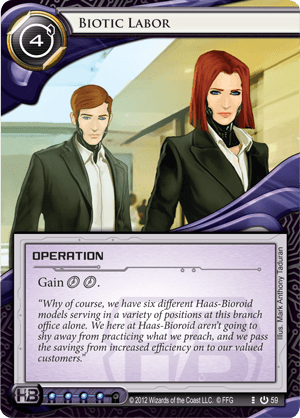 In the world of Android: Netrunner Haas-Bioroid are responsible for the construction of synthetic bioroids, artificial humanoids used for labour. Thanks to this reliable and cheap workforce Haas-Bioroid has become the corporation of labour and manufacturing. They are masters are performing multiple tasks at once. If a sudden need arises to work extra hours just throw some more bioroids at the problem. This absolute control of time management can also be seen in their ability to waste the runner’s time, draining them of clicks and limiting their ability to get anything done.
In the world of Android: Netrunner Haas-Bioroid are responsible for the construction of synthetic bioroids, artificial humanoids used for labour. Thanks to this reliable and cheap workforce Haas-Bioroid has become the corporation of labour and manufacturing. They are masters are performing multiple tasks at once. If a sudden need arises to work extra hours just throw some more bioroids at the problem. This absolute control of time management can also be seen in their ability to waste the runner’s time, draining them of clicks and limiting their ability to get anything done.
Their in-faction bioroid ICE have good strength to cost ratios, but come with the downside that their sub-routines can be broken by spending clicks. With enough time even the most dangerous bioroid can be reasoned with, or circumvented.
Haas-Bioroid is about progress, their core faction ability support a mindset of constantly installing. Not only do they have powerful assets and ICE, but they also possess several ways of returning cards to play if they are trashed. They may lack consistent means of inflicting physical damage on runners, but that doesn’t mean they are unable to take direct action. Officially, bioroids can’t harm humans. Unofficially, destroying software and melting the mind of any runner who attempts to access a secured server is much more efficient – not to mention cleaner – than blowing up their house. Because of this Haas-Bioroid are the faction of program destruction and brain damage.
The quintessential Haas-Bioroid card is Biotic Labor. For 4 credits you gain 2 clicks, meaning you get back the click you used to play Biotic Labour and an extra click. If played as your first click this means you now have now have 4 clicks total instead of 3. These clicks can be used for anything, though the classic example is to play Biotic Labour as your first click, install a 3 cost agenda, then advance and score it using the remaining clicks.
Bioroid’s provide an efficiency and reliable labour force, one Haas-Bioroid exploits to the fullest.
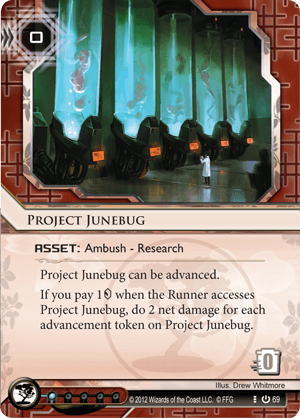 Jinteki are a vast bio-tech firm, responsible for both software development and medical research. Jinteki produced clones are an organic alternative to the bioroids manufactured by Haas-Bioroid. Through the Nisei project they have even begun to develop rudimentary psychic abilities.
Jinteki are a vast bio-tech firm, responsible for both software development and medical research. Jinteki produced clones are an organic alternative to the bioroids manufactured by Haas-Bioroid. Through the Nisei project they have even begun to develop rudimentary psychic abilities.
With medical research taking priority, Jinteki’s software development is geared toward cyber-security. Their ICE suite is one of the cheapest and they have several in-faction ways of rezzing ICE at a reduced cost. Despite this, Jinteki have a hard time keeping runners out of their servers through sub-routines alone. What they can do however is make any runs costly, even potentially deadly. They are the de facto net damage faction, with the greatest number of in-faction trap cards and damage dealing ICE.
As their creator, Jinteki also have access to psychic clones, along with psi based ICE, that forces the runner to attempt to read the corporation’s mind. Failure allows the corporation to leverage abilities that might otherwise be too over-powered. Through these psychic clones and other bio-tech research Jinteki are masters at gaining information on their own future, and adapting to events on the fly. They can see which cards are coming up in their own R&D, and even rearrange the order and placement of ICE to better adapt to threats as they emerge. Jinteki are the only faction with the ability to swap the position of any installed ICE. They can even force runners to face different ICE than they expected, or cause them to end their run on a different server than where they initiated it.
As a mega-corporation with a historical link to Japan, Jinteki also have connections within the Yakuza. These provide limited ways for them to take direct actions against runners.
Project Junebug is an asset that can be advanced like an agenda. The idea is to bait the runner into attempting to steal what looks like an agenda only to suffer the consequences. When the runner accesses Project Junebug the corporation can pay 1 credit to inflict 2 net damage per advancement token. At 3 advancement tokens this is enough to kill a runner through a full grip, but even at 1 or 2 the loss of cards can be game changing. Project Junebug can be especially deadly given how runners are likely to have had to get through damaging ICE before they reached the stage where they can access it. Even if the runner is able to avoid the net damage, or access Project Junebug while it is not advanced (such as from HQ or R&D), the presence of one in a deck can change their behaviour. All advanced cards now have to be treated with caution.
With Jinteki what you see isn’t necessarily what you get, and that poorly defended server might just be bait.
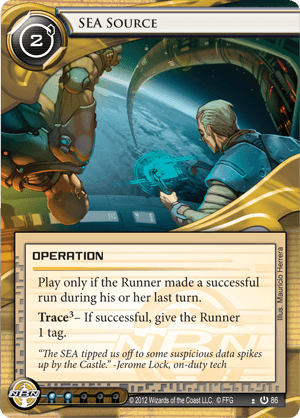 NBN are the media and communications giant of the Android: Netrunner universe. Specialists at locating the runner, tagging them, and using these tags either for their own benefit or as a means of draining the runner’s resources. With access to a vast wealth of information NBN have many abilities that allow them to draw cards, meaning they can get to what they need faster than any other faction; though their ability to filter for specific cards is limited.
NBN are the media and communications giant of the Android: Netrunner universe. Specialists at locating the runner, tagging them, and using these tags either for their own benefit or as a means of draining the runner’s resources. With access to a vast wealth of information NBN have many abilities that allow them to draw cards, meaning they can get to what they need faster than any other faction; though their ability to filter for specific cards is limited.
Their ICE is not the strongest or most damaging, but often comes with difficult to avoid “on encounter” effects that must be resolved before the ICE can be interacted with at all. These let NBN tag and tax runners even when they cannot keep them out entirely.
Through news broadcasts and entertainment shows NBN are able to saturate the world with their own messaging. From advertising to straight theft, NBN has various in-faction ways of gaining money. They can very rapidly swing the economic game in their favour, with devastating effects for the runner.
If the runner has made a run during their last turn, NBN have ways to find them. For 2 credits SEA Source allows them to initiate a trace with base strength 3 (the corporation can then pay further credits to increase the trace strength, the total of which the runner must match to avoid the trace being successful). If this trace is successful the runner receives one tag. SEA is the Space Elevator Authority, NBN have their sources everywhere, even miles above the surface of the earth.
NBN known everything about you. They’ll either use that to stop you, or simply to make more money.
The Weyland Consortium is a giant faceless conglomerate, even their CEO is never identified; instead their operations are directed by the mysterious Weyland board. Constituting multiple divisions and subsidiaries Weyland’s focus is on construction, security, and banking.
Weyland have their fingers in everything, they can get whatever they need when they need it. Of the four corporation factions Weyland are the only faction to have multiple ways to look for and draw specific cards.
Though their ICE suite heavily prioritises barriers and uncomplicated “end the run” sub-routines Weyland can increase the power of their ICE through advancement tokens. Investing time and money in something makes it stronger, that’s the Weyland philosophy.
Weyland are ruthless, willing to sacrifice their own scored agendas for future gains. The game isn’t over until it’s over, and whoever is left standing at the end is the winner, nothing else matters.
Like criminals, Weyland relies heavily on their presence in the physical world, here their various black and grey operations allow them to inflict meat damage, and destroy runner hardware. Owners of banks and a private military, Weyland are the experts at making money and inflicting damage upon the runner and their associates. Their reliance on sheer brute force is balanced by their lack of a consistent in-faction means of identifying and tagging the runner.
Like Weyland themselves, Scorched Earth is straightforward and blunt. For 3 credits, and provided the runner is tagged, you can inflict 4 meat damage. One of these played against you is painful, multiple are lethal. Any runner facing Weyland has to be mindful of dropping below 4 cards in their grip if they have no other means of meat damage protection. Scorched Earth is (at least before the release of its younger sibling BOOM!) the most common cause of runner death in Netrunner.
Weyland’s approach to problem solving is simple, remove the problem, and if necessary the entire city block the problem is in; then make money on the reconstruction.
Mechanics, factions, and identities. These three elements, supported by flavour text and card art, form the narrative foundation of Android: Netrunner. Understanding this foundation we can now explore how the Andorid universe is developed over time – through new cards and interactions – and how the player developed story of each individual Netrunner game can support a fictional reading.
